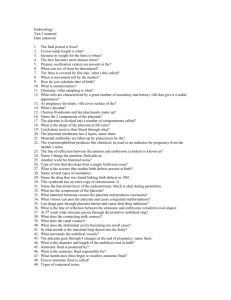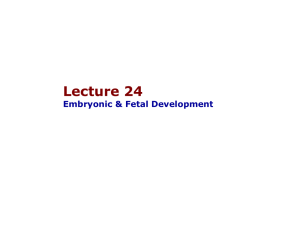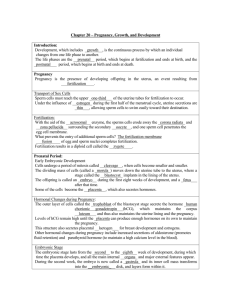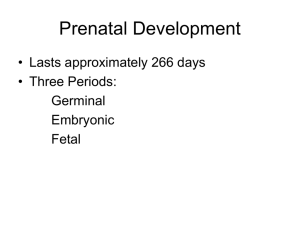7-Menst. cycle ,Ovulation
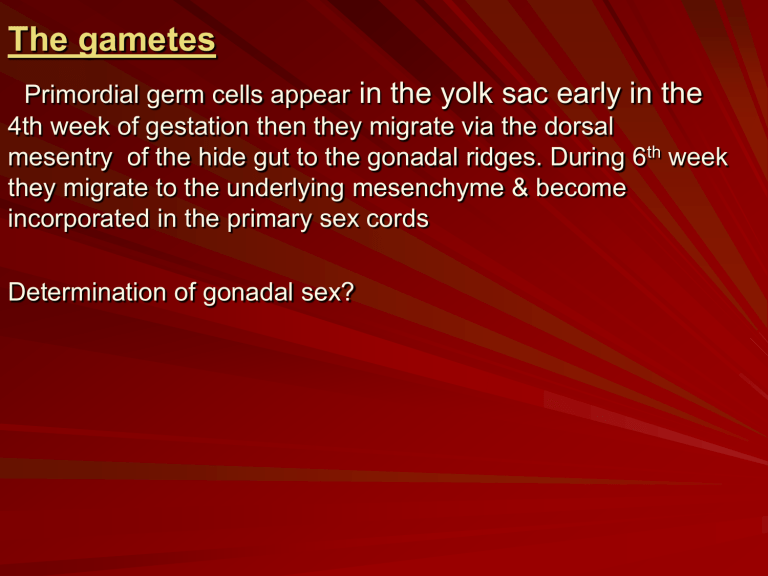
The gametes
Primordial germ cells appear in the yolk sac early in the
4th week of gestation then they migrate via the dorsal mesentry of the hide gut to the gonadal ridges. During 6 th week they migrate to the underlying mesenchyme & become incorporated in the primary sex cords
Determination of gonadal sex?
Spermatogenesis
With establishment of embrionic testis multiplication of germ cells ends& they enter a long resting phase
At puberty, the germ cells (spermatogonia) increase in no. and after several mitotic divisions , spermatogenesis is initiated
The total process of spermatogenesis from spermatogonium to mature sperm takes 72 days.
Oogenesis
During early fetal life the oogonia proliferate by mitotic division then enlarg to form the primary oocyte & ovarian stromal cells form a single layer of flattened cells around it . This structure is called the primordial follicle
In the human female fetus of 20 weeks of gestation there are 7 million oocyte .
Those primary oocyte are arrested at the prophase of the first meiotic division which is completed only after puberty just before ovulation
No primary oocyte is formed after birth , while there is continuous production of spermatocyte after puberty
Menstrual cycle & ovulation
At time of puberty the female begins to undergo a regular monthly cycles (menst. cycles) . The hypothalamus release GnRH that stimulate the cells in anterior pituitary which in turn will secrete the gonadotropin(LH & FSH) ,these hormones stimulate & control the cyclical changes in the ovary.
At the beginning of each ovarian cycle a no. of primordial fpllicles
(5 to 12) ,begin to grow under the effect of FSH . Under normal conditions only on of these follicles reaches full maturity & only one oocyte is discharged , the others degenerate & become atretic follicle which is replaced by fibrous tissue.
During the growth of the follicle , a large no. of cells will surround the oocyte ,the inner cells called Granolosa cells that secrete estrogen & the outer cells called theca interna &theca externa cells
Estrogen will stimulate pituitary gland to secrete LH which is needed for final follicular maturation & ovulation
Ovulation
In the days before ovulation the Graafian follicle increase rapidly in size under the effect of FSH & LH to diameter of 16 mm.
In the meantime the surface of the ovary begins to bulge locally
& on the apex an avascular spot appears, the so called
stigma
.
As a result of local weakening & degeneration of the ovarian surface, follicular fluid oozes through the stigma which gradually opens & subsequently the tension in the follicle is released & the ovum together with surrounding cumulus oophorus cells breaks free & float out of the ovary, this is called ovulation
At the same time of ovulation the primary oocyte will resumes & finishes its first meiotic division which result in the extrusion of first polar body & secondary oocyte ( ovum ) that is arrested at the metaphase of the second meiotic division that is only completed at time of fertilization
Corpus luteum
Following ovulation the remaining follicular cells in the wall of the ruptured follicle become vascularised by surrounding vessels & under the effect of LH these cells develop a yellowish pigment
& change to luteal cells which form the corpus luteum
&secrete progesterone which induce secretory changes in the endometrium in preparation for implantation of embryo.
Ovum transport
Shortly before ovulation , the fimbriae of the fallopian tubes begin to cover the surface of the ovary & the tubes itself begin to contract rhythmically.
The ovum surrounded by cumulus oophorous is carried into the tube by the sweeping movement of the fimbriae & the motion of the cilia of the lining epithelium
Once the oocyte is in the tube ,it is pushed toward the uterine cavity by contraction of the muscular wall .
The fertilized ovum reaches to the uterine cavity in about 4 days.
If fertilization failed to occur , the corpus luteum reaches maximum development about 9 days after ovulation & can easily recognized as a yellowish projection on the surface of the ovary. Subsequently it degenerate forming a mass of fibrous tissue known as
corpus albicans
thus progesterone production decreases thus precipitating menstrual bleeding.
If the ovum is fertilized , degeneration of corpus luteum is prevented by a gonadotropic hormone secreted by the trophoblast of the developing embryo (HCG) ,forming corpus luteum of pregnancy that continue to secrete progesterone till 8
-10 weeks of pregnancy then the developing placenta takes place of progesterone production.
Thus removal of corpus luteum before this period leads to abortion
Fertilization
Fertilization is the process by which the male & female gametes fuse, it occurs in the ampullary region of the tube which is the widest portion of it. If the ovum is not fertilized it will die after 24 hrs.
the spermatozoa pass rapidly from the vagina to the uterus then to the tubes & they should undergo changes to be capable of fertilizing the ovum, those changes are:
1. Capacitating : it take place in the female genital tract
During this process a glycoprotien coat & seminal plasma proteins are removed from the plasma membrane that overlies the acrosomal region of the sperm . Completion of capacitation permits the acrosome reaction to occur
2. Acrosome reaction : it occurs near the ovum , morphologically multiple points of fusion between the plasma mem.& the outer acrosomal mem. take place , permitting the release of the acrosomal content that are needed to penetrate the corona radiata & zona pellucida
During the acrosome reaction the following substances are released
1.Hyaluronidase needed to penetrate the corona radiata barrier.
2.Trypsin – like substance needed for digestion of zona pellucida.
3.Zona lysin attached to the inner surface of the acrosomal mem. also needed for penetration of zona pellucida.
AS soon as the sperm has entered the ovum ,the later respond in three different ways :
1.Cortical & zona reaction that the zona pellucida & plasma mem.
Become impenetrable to other sperm to prevent polyspermia.
2. Resumption of the second meiotic division resulting in send polar body & a large definitive oocyte forming the female pronucleus.
3. Metabolic activation of the egg
After the sperm has entered the oocyte it move forward until it lies in close proximity to the female pronucleus.
Its nucleus swollen forming male pronucleus. The tail is detached & degenerate. The main result of fertilization are:
1.Restoration of the diploid no. of chromosomes, thus the zygote have 46 chromosomes ,23 of paternal &
23 of maternal origin.
2.Determination of the sex of the new individual.
3.Initiation of cleavage. Without fertilization the oocyte usually degenerate 24 hrs after ovulation.
Cleavage & blastocyst formation
Once the zygot has reached the tow – cell stage ,it undergoes a series of mitotic divisions, resulting in a rapid increase in no. of cells. These cells , which become smaller with each cleavage division, are known as blastomeres
After three or four divisions the zygot, similar in appearance to a mulberry, is known as
morula.
This stage is reached about three to four days after fertilization
& the embryo is about to enter the uterus .At this time (16 cell stage) the morula consist of a group of centrally located cells
,the inner cell mass that give rise to the tissues of the embryo proper, and surrounding layer ,the outer cell mass that forms the
trophoblast
which later on contributes to the placenta
At about the time that the morula enters the uterine cavity , fluid begins to penetrate through the zona pellucida into the intercellular space of the inner cell mass .Gradually the intercellular space become confluent and finally a single cavity, the
blastocele
,is formed at this time the embryo is known as
blastocyst .
The cells of the inner cell mass, now referred to as embryoblast, are located at one pole, while those of the outer cell mass, or trophoblast, flatten &form the epithelial wall of the blastocyst.
The zona pellucida now disappear, allowing implantation to begin.
The trophoblastic cells over the embryublast pole begin to penetrate between the epithelial cells of the uterine mucosa at about 6 th day. This penetration & subsequent erosion of the epithelial cells of endometerium result from proteolytic enzymes produced by the trophpblast
Implantation
Following ovulation , the corpus luteum grows near the surface of the ovary as it produces progesterone . Under this hormonal influence , the endometrium & its glands undergoes rapid morphological changes leading them to secretory phase .
Other factors than gonadal steroid influence uterine receptivity for implantation which are local peptides such as growth factors including epidermal growth factor( EGF) , insulin – like growth factor -1 (IGF -1) & its binding protein (IGFBP -1) , plasminogen activator
By the sixth day ,the zygote orient itself towards the decidua & begin to penetrate its epithelia surface by piercing the basement mem. at the embryonic pole
Once inside the decidua it generate extracellur matrix (ECM) which is thought to enhance the chance of implantation . This process facilitate one of earliest embryo – maternalinteraction such as secretion of HCG by the trophoblastic cells leading to maternal recognition of pregnancy.
Endometrial cytokines modulate cytotrophoblastic proteolytic activity to control the depth of invasion.
By the 8 th day of developm. embryo is partially embedded in the decidua . The trophoblast at the area over the embryoblast differentiate into 2 layers
1.An inner layer of mononuclaeted cells , the cytotrophpblast.
2.An outer layer of multinucleated zone without distinct cell boundaries, the cynsytiotrophpblast or cynsytium.
The cells of embryoblast also differentiate into 2 layers
1.A layer of small cuboidal cells, the endodermal germ layer.
2.A layer of columnar cells, the ectodermal germ layer.
At the same time a small cavity appear within the ectoderm & enlarge to form the amniotic cavity. Those ectodermal cells adjacent to the cytotrophoblast are called amnioblast, & together with the rest of ectoderm they line the amniotic cavity.
There is hypereamia & oedema at & adjacent to the implantation site that can be seen as 1mm red spot on the mucosa at about 11-12 days due to maternal blood in lacunar space .
D
Day 8
By day 9 lacunae develop in the syncytiotrophoblast & when maternal sinusoids are eroded by the syncytium , maternal blood enters the lacunar network & by the end of the second week a primitive
uteroplacental circulation
begins .
The penetration defect in the surface epithelium is closed by fibrinous material.
The cytotrophpblast , meanwhile, forms cellular columns penetrating into & surrounded by the syncytium. These columns are the primary stem villi. By the end of the second week the blastocyst is completely embedded & the surface defect in the mucosa has healed.
day 9
day 12
Day 13
Embryonic period
It is the period following fertilization that the re is differentiation of cells into specialized tissues, to form inter-related organ systems. It start with the generation of the embryonic disk during 2 nd week post fertilization & ends by the last day of the
8 th week (10 week after the last menstrual period) . At this point all organ systems are formed ,but not necessarily mature or functioning.
3
rd
week
On the dorsal aspect of the bilaminar germ disk a faint groove, the primitive streak, appears on the midline near its caudal end
& it will determines symmetry & defines the cephalic & caudal poles of the embryo.
During 3 rd week, tow other structures become apparent on embryonic disc , the neural plate & the somites which appear as symmetric eminencies
Internally , the bilaminar embryo generates the mesodermal layer made up of cells which forms the primitive node , at the cephalic end of primitive streak,& migrate between endodermal
& ectodermal layers
The somites composed of paraxial mesodermal cells will appear at day 20, at a level corresponding to the future base of skull.
the primery yolk sac (extra embryonic structure) also grow rapidly during this period & is necessary for exchanging metabolites bet. Mother & embryo at that time when there is no placenta It will degenerate by the end of 6 th week
The amniotic mem. Is another extra embryonic structure that develops during this period.
4
th
week
During this week the embrionic disc folds into an embrionic cylinder within which is a cranio – caudal blind-ending tube which has 3 segments , the foregut , the mid-gut opened to the developing yolk sac & the hindgut. This stage marks the start of organogenesis.
The 1 st organ to become apparent is the primitive heart in the form of a forward buckling loop. cardiac activity is evident by day 22 post fertilization.
Development of nervous system , takes place at this stage& by the end of 4 th week the central nervous system has defined segments.
Toward the end of 4 th week , the foregut septates along the midline into the respiratory &digestive primitive elements. Also the mesonephric duct & the mesonephros will
In summary ,by the end of the 4 th week the ,almost all organ systems ,till immature , can be identified
Toward the end of 4 th week the body of embryo is attached to the yolk sac by a broad viteline duct & two connecting viteline blood vessels .The yolk sac is placed within the exocoelomic space. The viteline duct & vessels are included within the umbilical cord just before the cord enters into the amniotic sac.
In the cephalic pole of the embryo , five pharyngeal arches appear in succession .
Further development of trophoblast
By the beginning of the 3 rd week the trophoblast is characterized by
primary stem villus
which consist of a cytotrophoblastic core covered by a syncytial layer.
During further development ,mesodermal cells penetrate the core of primary villi & grow in of decidua, this newly formed structure is called the
secondary stem villus
.
By the end of the 3 rd week the mesodermal cells in the core of the villus begin to differentiate into blood cells & small blood vessels, thus forming the villous capillary system. The villus now is known as
tertiary stem villus
.
The capillaries in the tertiary villi make contact with capillaries developing in the mesoderm of the chorionic plate & in the connecting stalk. These in turn establish contact with the intraembryonic circulatory system , thus connecting the placenta & embryo
Hence ,when the heart start to beat in the 4 th week of development, the villous system is ready to supply the embryo with the necessary nutrient & oxygen.
Meanwhile, the cytotrophoblastic cells in the villi penetrate into the overlying syncytium until they reach the maternal decidua.
Here they establish contact with similar extension of neighboring villous stem, thus forming a thin outer cytotrophoblastic shell.
By the 20 th day the embryo is attached to its trophoblastic shell by a narrow
connecting stalk.
The connecting stalk later develops into the umbilical cord which forms the connection between the placenta & the embryo.
From time of their formation in the 3 rd week till the end of 1 st trimester , the villi are covered by a single layer of cytotrophoblast & an outer layer of syncytium which is in immediate contact with maternal blood in the intervillous space.
After 20 weeks the cytotrophoblast begin to disappear & finally only a thin layer of capillary endothelium & syncytial membrane which separate between fetal & maternal blood.
Further development of the placenta
The chorionic villi are formed in huge no. & constitute the bulk of the placental area.
At first the villi are formed allover the surface of gestational.
As growth proceed, the decidua capsularis becomes thinner
& between 12 & 16 weeks , the villi on the decidua capsularis degenerate rapidly leaving this side of the chorion smooth
(chorion leave)
In compensation, the villi on the surface opposed to the dicidua basalis undergoes a great deal of hypertrophy
(chorion frondosum)
& become matted into a solid disc which the fully developed placenta which is formed by the 10th week.
Placenta at term
The placenta at term is cicular forming a spongy disc 20 cm. in diameter & 3cm. In thickness 7 its weight is about 500 gm. But there is direct relation with fetal weight.
The placenta has a fetal & maternal surface .
The fetal surface is covered smooth amnion underneath the chorion.
The maternal surface is rough & spongy & presents a number of polygonal areas known as
cotyledons
which are seperated by shallow grooves
There are about 15 – 20 cotyledon & each one is corresponding to a main villous system of branched villi.
The placenta is dull red in color & grey spots are frequently seen on maternal surface which are the result of deposition of calcium in the degenerated area & are more frequent after term.
The chorion spread away from the edge of the placenta to form the outer layer of fetal membranes which enclose the fetus & amniotic fluid. The chorion & placenta are of the same origin.
The amnion which is a thinner layer underneath the chorion & can be separated from chorion after birth.
The umblical cord usually reaches the fetal surface of placenta at the midline of its disc but sometimes at its edge.
Blood coming to placenta from fetus through 2 umbilical arteries
& drained into a single umbilical vein
Functions of placenta
1.It act as fetal lung by continuous exchange of o
2 & co
2
2.Transport of nutrient material so it act as GIT during intrauterine life.
3.Excreation of waste material & H ion, so it replace the function of the kidney.
4.It play a role in the immune system of the fetus by transporting
Ig from maternal circulation & also it act as a barrier against transport of some infections to the fetus.
5.It replace the function of the liver by detoxification of drugs & chemical materials that are present in the maternal circulation.
6.It has an endocrine function by secretion of some hormones as estrogen, progesterone, HCG, lactogen, relaxin. These hormones are secreted into the maternal circulation.
The estrogen secretion increase gradually during pregnancy & reach its peak level gust before labour & it is mainly estriol.
The placenta synthesize estriol from androgenic precursor which come from fetal adrenal.
Progesterone secretion is from corpus luteum till about 10 weeks , then the placenta becomes responsible for its secretion
& reaches its peak level just before labour .
Regarding HCG ,the β subunit can be detected in maternal serum as early as 9 days after fertilization & in urine after 13 days from fertikization
It reaches its peak level in serum & urine at 8 – 10 weeks & decreases thereafter.
It disappear from urine 7 days after termination of pregnancy.
Placental transport
The trophoblast & the underlying endothelium of fetal vessels behave as semipermable membrane ,allowing the free passage of water & soluble substances of relatively low molecular weight
(less than 1000) according to the law of osmotic equilibrium.
But there are other mechanism for transport across the placenta:
1.Simple diffusion : passage of the substance from area of high concentration to area of low conc. According to chemical or electrochemical gradient as oxygen.
2.Facilitated diffusion: transport is facilitated by a carrier molecule
& it does not require energy as transport of glucose.
3.Activ transport: requires a carrier molecule & energy because it occur against chemical gradient as iron , amino acids.
4.Bulk transport: in this mechanism , water & small dissolved molecules cross the membrane more quickly than by simple diffusion.
5.Pinocytosis: the substance is enveloped by the cell membrane to form a vesicle which is transported across thr placental membrane.
6.Villous damage: a small break in the villous surface can allow the passage of fetal blood cells into maternal circulation.
By this mechanism some bacteria, protozoa &T.Pallidum cross the placenta
Efficient placental transport will depend on :
1.Maternal blood flow through the intervillous space.
This will depend on blood flow rate through uterine artery & spiral arteriols (at term 8oo ml/min).
It is also affected by uterine contraction spatially during late pregnancy & labour.
2.The effective surface area of the chorionic villi.
3. The fetal blood flow through the chorionic villi (about 300 ml/min through the fetal capillaries.
The umbilical cord
The umbilical cord is the major connection between the fetus & the placenta. It is derived from the ventral stalk.
The umbilical cord compose of :
1.Covering epithelium which is the amnion.
2.Wharton
’s jelly which originate from extra-embryonic mesoderm
& consist of cells elongated processes in a gelatinous fluid.
3.Blood vessels : at first they are 4 in number ,2 arteries & 2 veins , after 12 weeks the veins unites to form a single umbilical vein which carries oxygenated blood from placenta to the fetus .
The umbilical arteries originated from internal iliac (hypogastric arteries) of the fetus & carry reduced blood from fetus to the placenta.
4.Umbilical vesicle & its duct which is the remnant of the yolk sac may be found as a small yellow body near attachment of the cord to the placenta.
5.The allantois which occasionally found as a blind tube just reaching into the cord & it is continuous inside the fetus with the urachus & bladder.
The cord length is about 50 cm. & about 1 cm thickness , but it is not uniform in thickness due to the presence of nodes & swelling. These are called
false knots
,they are caused by local dilatation of umbilical vein or mostly due to localized increase in Wharton ’s jelly.
The cord may show a true knots due to the passage of the fetus through a loop in the cord & these may cause impairment of feto-placental circulation.
The cord may be coiled around fetal body , limbs or neck but this does not cause serious problem unless it is coiled around the neck more than 1 time then tension on the cord during the
2 nd stage of labour with the descend of the fetus & this tension may obstruct the feto-placental circulation & lead to fetal distress
